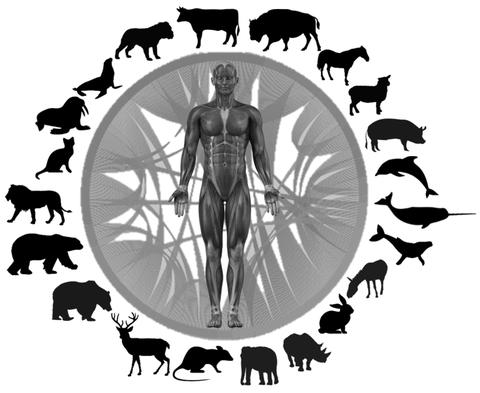Summary
NIST is developing a portal to enable researchers to mine high-quality proteomic data from phylogenetically diverse species to identify advantageous biological adaptations and advance human biomedical breakthroughs.
NIST is seeking partners to contribute samples, provide biological expertise, improve bioinformatic capabilities in non-model species, and inform new areas of biomedical research.
Description

The field of comparative proteomics complements comparative genomics as an orthogonal approach that may accelerate human biomedical discoveries.
Comparative proteomics strives to gain insight into key underlying molecular changes that result in unique phenotypes across related taxa. Proteomic analysis complements comparative genomics by providing evidence of protein abundance, orthogonal to gene copy number and amount of transcript. To realize the potential of comparative proteomics in accelerating human biomedical discoveries, data from a variety of mammals must be acquired in a standardized fashion. NIST and its partners are uniquely situated to undertake this effort with access to unique and diverse samples, developing and defining standard protocols, acquiring data on state-of-the-art instrumentation, and providing a platform to disseminate the resulting data. This resource will be foundational to advances related to the bioeconomy and health initiatives, and will provide an invaluable resource to biomedical researchers, governmental agencies, and software developers, accelerating development and discoveries.
Comparative proteomics studies diverse species to better understand traits that may help mitigate chronic human disease (e.g., acute kidney injury, stroke, myocardial infarction). Through the evolution of millions of species over billions of years, diverse molecular solutions exist for adaptation and speciation. For instance, diving mammals can deal with ischemia/reperfusion stress, and hibernating mammals can avoid cardiac stress and uremia. Due to the high degree of protein homology between mammalian species, humans often possess similar molecular machinery, and therefore, insights are likely translatable to humans. The CoMPARe Program will generate data sets in a standardized fashion and develop a web portal for stakeholders to access and explore results to facilitate biomimetic discoveries and accelerate biomedical advances.
How to contribute
If you would like to learn more or assist with the project, please email benjamin.neely [at] nist.gov (benjamin[dot]neely[at]nist[dot]gov).
Publications
Albery GF, Becker DJ, Brierley L, Brook CE, Christofferson RC, Cohen LE, Dallas TA, Eskew EA, Fagre A, Farrell MJ, Glennon E, Guth S, Joseph MB, Mollentze N, Neely BA, Poisot T, Rasmussen AL, Ryan SJ, Seifert S, Sjodin AR, Sorrell EM, Carlson CJ. 2021. The science of the host-virus network. Nat Microbiol 6(12):1483-1492. [link]
Neely BA and Palmblad M. 2021. Rewinding the molecular clock: looking at pioneering molecular phylogenetics experiments in the light of proteomics. J Prot Res 20(10):4640-4645. [link]
Khudyakov JI, Treat MD, Shanafelt MC, Deyarmin JS, Neely BA, van Breukelen F. 2021. Liver proteome response to torpor in a basoendothermic mammal, Tenrec ecaudatus, provides insights into the evolution of homeothermy. Am J Physiol Regul Integr Comp Physiol. 321(4):R614-R624. [link]
Peart CR, Williams C, Pophaly SD, Neely BA, Gulland FMD, Adams DJ, Ng BL, Cheng W, Goebel ME, Fedrigo O, Haase B, Mountcastle J, Fungtammasan A, Formenti G, Collins J, Wood J, Sims Y, Torrance J, Tracey A, Howe K, Rhie A, Hoffman JI, Johnson J, Jarvis ED, Breen M, Wolf JBW. 2021. Hi-C scaffolded short- and long-read genome assemblies of the California sea lion are broadly consistent for syntenic inference across 45 million years of evolution. Mol Ecol Res 21, 2455– 2470. [link]
Neely BA, Janech MG, Fenton MG, Simmons NB, Bland AM, Becker DJ. 2021. Surveying the vampire bat (Desmodus rotundus) serum proteome: a resource for identifying immunological proteins and detecting pathogens. J Prot Res 20(5): 2547–2559. [link]
Neely BA. 2021. Cloudy with a chance of peptides: accessibility, scalability and reproducibility with cloud-hosted environments. J Prot Res 20(4): 2076–2082. [link]
Heck M, Neely BA. 2020. Proteomics in non-model organisms: A new analytical frontier. J Prot Res 19(9):3595-3606. [link]
Neely BA, Prager KC, Bland AM, Fontaine C, Gulland FM, Janech MG. "Proteomic analysis of urine from California sea lions (Zalophus californianus): a resource for urinary biomarker discovery." J. Prot. Res. 17(9):3281-3291 (2018). [link]
Neely BA, Ellisor DL, Davis WL. "Proteomics as a metrological tool to evaluate genome annotation accuracy following de novo genome assembly: a case study using the Atlantic bottlenose dolphin (Tursiops truncatus)". bioRxiv doi:10.1101/254250 (2018). [link]
Sobolesky P, Parry C, Boxall B, Wells R, Venn-Watson S, Janech MG. "Proteomic Analysis of Non-depleted Serum Proteins from Bottlenose Dolphins Uncovers a High Vanin-1 Phenotype." Scientific Reports 6:33879 (2016). [link]
Neely BA, Soper JL, Gulland FMD, Bell PD, Kindy M, Arthur JM, Janech MG. "Proteomic analysis of cerebrospinal fluid in California sea lions (Zalophus californianus) with domoic acid toxicosis identifies proteins associated with neurodegeneration." Proteomics 15(23-24):4051-63 (2015). [link]
Neely BA, Ferrante JA, Chaves JM, Soper JL, Almeida JS, Arthur JM, Gulland FMD, Janech MG. "Proteomic analysis of plasma from California sea lions (Zalophus californianus) reveals apolipoprotein E as a candidate biomarker of chronic domoic acid toxicosis." PLoS One 10(4):e0123295 (2015). [link]
Neely BA, Carlin KP, Arthur JM, McFee WE, Janech MG. "Ratiometric measurements of adiponectin by mass spectrometry in bottlenose dolphins (Tursiops truncatus) with iron overload reveal an association with insulin resistance and glucagon." Front Endocrinol 4:132 (2013). [link]

